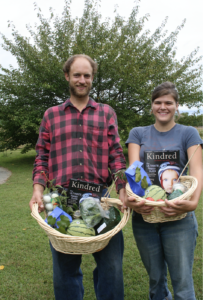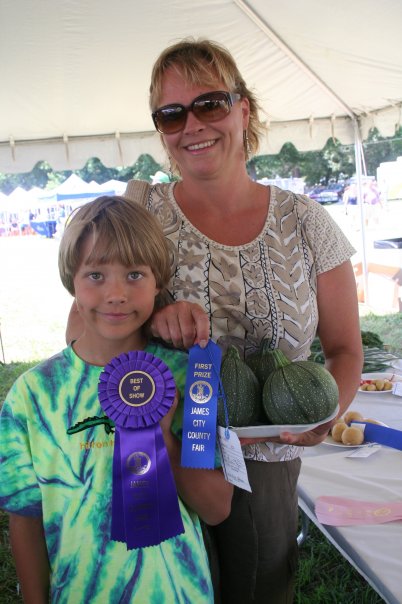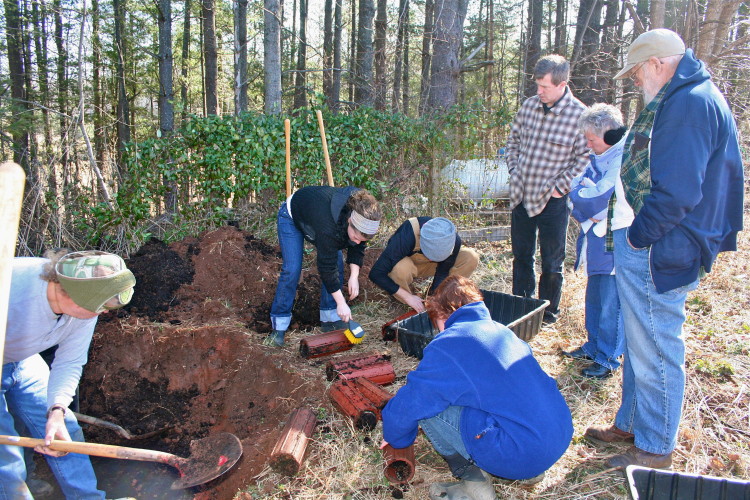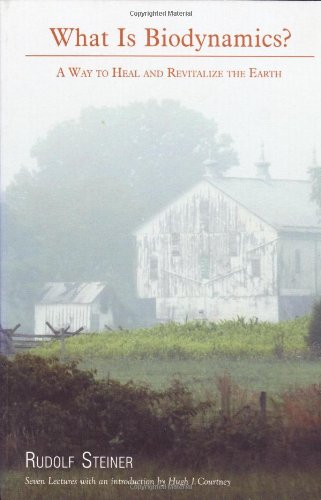Beyond Sustainability – The Regenerative Promise Of Biodynamics
Caption: Butterfly garden and barn on Ceo Maidin Feirm, the author’s home. See more photos here. Photo by Lisa Reagan.
Standing under the news-making conjunction of Venus and Jupiter in the night sky this past February, I realize, once again, the frogs are early. So were the tiny, native blossoms covering the hillside under my feet. These traditional heralds of spring are childhood friends who usually lift my spirits out of winter’s chill, but another balmy winter in Southeastern Virginia blurred the frost and planting dates, as well as my emotions on welcoming my old friends.

The next day I hike through the woods with my son to his new fort, built in a hundred-year-old oak blown down by one of last fall’s hurricanes—more evidence of climate change, as warming ocean temperatures are brewing increasingly powerful storms. On my walk through the woods, I am observant and open. This forest, I know, is the real model of life I wish to emulate in my garden during this early-arriving spring: a perfectly balanced, self-regulating ecosystem that effortlessly grows food and provides shelter for its inhabitants.
It is meaningful that the word humility’s root is humus, the Latin for soil. Anyone who has worked with the soil of this Earth for very long will find herself humbled by its profound ability to rebirth life from the seemingly dead matter of a compost pile into living plants, season after season. It is those few steps from inside the forest to an intensely, mechanically cleared, tilled, planted and harvested piece of Earth that reveals the truth about farming…and more important, our own consciousness. As my son and I step through the forest’s edge and back onto the cleared pastureland of our small farm, we also step into an uncomfortable truth: farming isn’t natural.
“The mind is more comfortable in a landscaped park because it has been planned through thought; it has not grown organically. There is an order here that the mind can understand,” writes Eckhart Tolle in A New Earth. “In the forest, there is an incomprehensible order that to the mind looks like chaos…. As soon as you sense that hidden harmony, that sacredness, you realize you are not separate from it, and when you realize that, you become a conscious participant in it. In this way, nature can help you become realigned with the wholeness of life.”
In New Roots for Agriculture, Wes Jackson points out that “A profound truth has escaped us. Soil is a placenta or matrix, a living organism which is larger than the life it supports, a tough elastic membrane which has given rise to many life forms…. But it is itself now dying. It is a death that is utterly senseless, and portends our own.”
The impact of the industrial approach and its nutrientempty produce makes daily headlines and inspires a growing wave of home gardeners, locavores and food activists. While this shift towards a more sustainable food system is great, is it enough? Or do efforts need to be made to restore and heal the Earth? How will we heal the Earth without healing our own consciousness and the disconnect that destroyed the living soil and created superweeds and chemically toxic rivers in the first place?
Is there an approach to working in partnership with living forces of the Earth that humbly concedes the act of growing food on a large scale isn’t “natural” at all, but can be done in a way that elevates our own consciousness while increasing the health and vitality of the Earth? I believe the answer is yes.
Romancing the Farm
When we moved to this little farm, I admit that my husband and I had some romantic notions about homesteading, inspired by the cute little red barn and tree swing by the frog pond. But ten years later, we wholeheartedly agree with relationship guru Harville Hendrix, who says “romance” is the anesthesia that gets you into position to do your personal work…and onto your soul’s path.
After burning through our romantic ideations on many levels in 24 years of marriage, we are here to tell anyone who listens that farming and marriage are both doorways to a rewarding place of deep relationship and soul adventures…if you hang in there through the waking-up process!

As we discovered, we weren’t the only ones romancing the farm. In the years that we ran a community supported agriculture program, CSA, you would have thought we were dealing in something other than squash the way perfect strangers pulled up to our home, banged on the front door, looked around hungrily at the rolling hills and gardens, and demanded to buy organic produce on the spot. There was no sign pointing to our house from the road or long dirt driveway, so I was never sure how they found us in the first place. (As a CSA, our clients signed up at the beginning of the season and we picked and dropped off produce twice a week in town.)
This shared experience with other Virginia growers was not uncommon. In fact, it was acknowledged among a few of us that the unnerving and escalating consumer demand couldn’t really be about that perfect slicing heirloom tomato. Could it?
Something is being overlooked in the burgeoning number of farmer’s markets, natural grocers and big box stores, whose increasing demand for organic produce has so outstripped the number of local organic farmers that we now import “organic” produce from China. Nowhere in this current scenario does the word “sustainable” apply. Nowhere.
Even the local, sustainable farms that do exist in the United States are up against a billion-dollar, fast-food industrial agriculture system funded by government subsidies and propped up by immigrant worker wages and slave labor (read the book The Nobodies by John Bowe for more on slavery in the United States).
However, in late 2011, an interesting silver lining appeared on the dark cloud surrounding the future of farming in the United States, when the Beginning Farmer and Rancher Opportunity Act was introduced in congress. The act, cosponsored by the National Sustainable Agriculture Coalition, NSAC, is a “sign of awareness of the need for farmers,” but acknowledges that the high barriers to entry “make farming and ranching one of the hardest careers to pursue.”
“Limited access to land and markets, hyperinflation in land prices, high input costs, farm and tax policy disadvantages, and lack of training discourage many would-be producers from entering agriculture,” states the NSAC’s website. “As a result, the average American farmer is now 57 years old, and the fastest growing group of farm operators are those 65 years and older.”
What an exceptional opportunity this could be in the coming years, if substantial and ongoing federal funding is committed to creating a new generation of farmers. Just as my family was lured into a relationship with the Earth through romantic notions, I am sure many others will be, as well.
While it took years of exploring a variety of sustainable farming practices before we finally hit upon one that included our own consciousness as a part of the health and healing of ourselves and the Earth, we are impressed with the high quality of food and relationship with the Earth that Biodynamics produces. With a truly sustainable and holistic approach, Biodynamics seeks to reconcile the split in the human as well as the few discernible inches between the self-sustaining forest and farmland.
“As the farmer grows, so grows the community and the culture. Those people who grow the food and tend the animals, and cultivate the fibers, are among the most important people in our society,” writes Parker Forsell, the Biodynamic program coordinator at Angelic Organics (managed by “Farmer John” Peterson of the documentary, The Real Dirt on Farmer John). “It is not the sports stars or the Hollywood movie stars that are the hub of culture. The farmers with their hands in the soil, or on the bodies of baby animals, or on the wheels of the grain combine enable us all to think good thoughts, to feel warmth in our hearts, and to run, and jump and grow in our bodies.”
The Origin of Biodynamics

Biodynamics began when German farmers—at the height of the agricultural crisis brought about by new chemical fertilizers in the early 20th century—became concerned about the decreasing fertility in their soil and increasingly diseased cattle. The farmers turned to Austrian philosopher and scientist Rudolf Steiner for help. Steiner, initially an editor of the scientific works of Johann Wolfgang von Goethe, integrated his disciplined scientific mind with his spiritually gifted clairvoyance to found Anthroposophy—the philosophy of spiritual science that led to Waldorf education, the movement art form of eurythmy, and valuable contributions to medicine, architecture, drama and poetry.
Only after being intensely persuaded for many years, the story goes, Steiner finally answered the German farmers’ requests for help. In his series of eight lectures, entitled The Agriculture Course, presented less than a year before his death in 1925, Steiner provided a new science of cosmic influences that would reorient the farmers and enable them to grasp his recommendations for creating the nine preparations and a cosmically influenced planting and harvesting calendar. In his sixth lecture, Steiner pointed out that when we look at something through a microscope, our focus blocks out the rest of the universe. The more we concentrate on the microscope, the more we block the macrocosm.
“They didn’t get it,” says Hugh Courtney, founder of the Josephine Porter Institute for Applied Biodynamics, JPI, in a phone interview. “They didn’t understand a word of what he said. They took the information into hiding. It took years for people to understand how to make the preparations and work with the Biodynamic calendar.”
A retired naval commander, Courtney founded JPI in 1985 on a 100-acre cattle farm in Woolwine, Virginia, to carry on the lifelong work of Josephine Porter, who created Biodynamic preparations for three decades in the U.S. The institute hosts international groups throughout the year and teaches hands-on the creation of the Biodynamic preparations, which Courtney says has made him a “heretic” in some circles.
“The Biodynamic movement is growing, but we are still young, probably in our kindergarten phase,” shared Courtney.
Biodynamics Predates the Organic Movement

Unlike chemical and some organic fertilizers that are often grown, mined and shipped long distances, killing the sustainability of the system, the nine Biodynamic preparations can be made on-farm with naturally occurring plant and animal materials combined in specific recipes in certain seasons of the year. The concentrated forces within the preparations are used to organize the chaotic elements within the compost piles, and sprayed directly onto the soil and plants. When the process is complete, the resulting preparations are medicines for the Earth that draw new life forces from the cosmos. Effects of the preparations have been verified scientifically.
“When Newsweek and Time magazine call, trying to explain it to them is fascinating,” said Jim Fullmer, the director of Demeter USA, in a phone interview. “The media leave behind the description of the preps. You can’t put it into sound bites and get a point across. It is more about an inner feeling than an intellectual thought. How do you express that to someone who hasn’t even given it a thought?”
But scientists and farmers alike are now forced to give the future fertility of the living Earth’s soil deep consideration since:
- Only about 42 to 84 years’ worth of topsoil remains worldwide.
- Current agricultural practices destroy approximately 6 pounds of soil for each pound of food produced.
- Conventional agricultural practices deplete the soil 18 to 80 times more rapidly than nature can build it.
- Even organic farming depletes the soil 17 to 70 times faster than nature builds it by importing organic matter and minerals from other soils, which thereby become increasingly depleted.
- 57 million tons of topsoil is lost every day.
- In the past 100 years, one-third of the topsoil of American farms has been lost.
According to Peter Tompkins and Christopher Bird in their book Secrets of the Soil: New Solutions for Restoring Our Planet, the fairy-tale promises of chemical agribusiness were spawned in the middle of the last century when the father of chemical agriculture, Justus von Liebig, “mistakenly deduced from the ashes of a plant he had burnt that what nourished plants was nitrogen, phosphorous, and potassium—the NPK of today’s chemical agriculture…. That the secret to fertilizing soil lay in organic excreta, not chemical, Liebig only concluded ten years later. Too late. By that time, the chemical companies were off to such a profitable start there was no stopping them in their headlong race to destroy the soil and all that it supports.”
With the current international attention on climatechange issues, including the extensive planetary damage of agribusiness and the industrialization of organic agriculture, Fullmer says, “It is now that Biodynamics is starting to come into reality, and we have to get ready. Humanity is only evolving, and I think we are evolving to the point where we can grasp this stuff: that we are not the center of the universe and that the planets and stars, that all of it is interconnected.
“We’re seeing a lot of interest because people are starting to wake up,” he continues. “If you have a kinship with agriculture, Biodynamics is a natural progression. A lot of cultures in ancient times did this—followed the stars and planets and using homeopathic remedies. This is not a new thing; it is an ancient thing. When Rudolf Steiner created Biodynamics he was pulling on the peasant wisdom from his part of the world. Biodynamics is a modern incarnation with the ancient.”
Biodynamics predates the “organic” movement— named and popularized in the 1940s by publisher J.I. Rodale in the United States. Today, “‘organic’ is now dead as a meaningful synonym for the highest quality food,” states Eliot Coleman, author of The New Organic Grower, who blames the industrialization of the organic movement on its inability to stay true to its origins.
“The transition of ‘organic’ from small farm to bigtime is now upon us,” says Coleman. “Although getting toxic chemicals out of agriculture is an improvement we can all applaud, it only removes the negatives. The positive focus, enhancing the biological quality of the food produced, is nowhere to be seen. The new standards are based on what not to do rather than what to do.”
The Regenerative Promise of Biodynamics
 According to the Demeter Association, in day-to-day practice, Biodynamic farming involves managing a farm as an individual and living organism. A concise model of a living organism ideal would be a wilderness forest. In such a system, there is a high degree of self-sufficiency in all of the realms of biological survival. Fertility and food arise out of the recycling of the organic material the system generates. Avoidance of pests is based on biological vigor and its intrinsic biological and genetic diversity. Water is efficiently cycled through the system. “While agriculture immediately takes nature to a state that is one step removed from wilderness, the wisdom of humanity that steers its course can, to a large degree, mimic these ancient principles of sustainability, based on a careful observation of nature as a whole,” states the Demeter website.
According to the Demeter Association, in day-to-day practice, Biodynamic farming involves managing a farm as an individual and living organism. A concise model of a living organism ideal would be a wilderness forest. In such a system, there is a high degree of self-sufficiency in all of the realms of biological survival. Fertility and food arise out of the recycling of the organic material the system generates. Avoidance of pests is based on biological vigor and its intrinsic biological and genetic diversity. Water is efficiently cycled through the system. “While agriculture immediately takes nature to a state that is one step removed from wilderness, the wisdom of humanity that steers its course can, to a large degree, mimic these ancient principles of sustainability, based on a careful observation of nature as a whole,” states the Demeter website.
With a philosophy broad enough to provide a context of the Earth as a living entity, with plants being influenced by forces deep within the Earth, as well as the movements of planets in the heavens, broader and truer questions can emerge, such as: “Can the Earth heal itself, or has the waning of the Earth’s vitality gone too far for this?”
Sherry Wildfeuer, editor of the Stella Natura Biodynamic Agriculture Planting Guide and Calendar, poses this question and answers, “Organic agriculture rightly wants to halt the devastation caused by humans; however, organic agriculture has no cure for the ailing Earth. From this the following question arises: What was the original source of vitality, and is it available now?
“Biodynamics is a science of life forces, a recognition of the basic principles at work in nature, and an approach to agriculture that takes these principles into account to bring about balance and healing,” Wildfuer continues. “In a very real way, then, Biodynamics is an ongoing path of knowledge rather than an assemblage of methods and techniques.”
Patrick Holden, former president of the U.K. Soil Association, advocates an integration of the macrocosmic context that Biodynamic practices can bring to farmer, farm and the humanity they feed. “If we do not bring in this deeper dimension of inner work and of the harmonious development of human beings who are recognized to be more than mere material organisms, if the organic movement does not embrace the ideas and impulses of the Biodynamic movement and remain open to them, I think there is a very serious risk that all the energy and all the ideas…will be lost and the opposite will take hold,” writes Holden. “The industrialization of farming, including the industrialization of organic farming, compromises public and cultural health. This problem is with us now, and we have to do something about it.”
Fullmer and Courtney both agree that if “those who have ears to hear” will do so in the coming years of planetwide shifting, Biodynamics could provide the missing, integrating context that would allow humanity to tote the industrial agriculture model, and the disconnected human consciousness that spawned it, to the cosmic compost pile. It is there, beyond our microcosmic view of the Earth and romantic ideas of farming, that we will find new seeds of sustainability.


